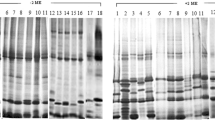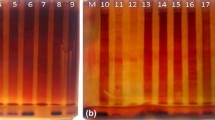Summary
The curds of cauliflowers (Brassica oleracea var. botrytis L.) which are representative of the European biennials, European annuals and Australian types were used to extract 12 of the enzymes involved in carbohydrate and amino acid metabolism. Each enzyme was separated into their isoenzymes using polyacrylamide gel electrophoresis. Two enzymes, acid phosphatase EC 3.1.3.2. and aspartate aminotransferase EC 2.6.1.1. were shown to have different numbers of isoenzymes depending upon which of the three main groups of cauliflower cultivars were used. The enzymes examined showed evolutionary divergence of the cauliflower types during the selection for different times of development.
Similar content being viewed by others
References
Austing, R. B., 1970. Growth and development studies: Cauliflowers. Rep. Natn. Veg. Res. Stn. for 1969, 64.
Bradford, M. M., 1976. A rapid and sensitive method for the quantification of microgram quantities of protein utilizing the principle of protein dye binding. Anal. Biochem. 72: 248–254.
Brewer, G. J., 1970. An introduction to isoenzyme techniques. Academic Press, New York.
Crisp, P., 1982. The use of an evolutionary scheme for cauliflowers in the screening of genetic resources. Euphytica 31: 725–734.
Harris, H. & D. A., Hopkinson, 1976. Handbook of enzyme electrophoresis in human genetics. North-Holland, London.
Hobson, G. E., 1974. Electrophoretic investigation of enzymes from developing Lycopersicon esculentum fruit. Phytochem. 13: 1383–1390.
Horne, F. R., 1954. Winter cauliflower: history and breeding in the South West. Sci. Hort. 11: 128–139.
Maurer, H. R., 1971. Disc electrophoresis. Walter de Gruyter. New York.
Nieuwhof, M., 1969. Cole crops: Leonard Hill, London.
Notton, B. A. & E. J., Hewitt, 1971. Incorporation of radioactive molybdenum into protein during nitrate reductase formation and the effect of molybdenum on nitrate reductase and diaphorase activities of spinach (Spinacea oleracea L.) Plant Cell Physiol. 12: 465–477.
Sadik, S., 1967. Factors involved in curd and flower formation in cauliflower. Proc. Am. Soc. Hort. Sci. 90: 252–259.
Author information
Authors and Affiliations
Rights and permissions
About this article
Cite this article
Allen, B.W., Goodenough, P.W., Lee, J.S.C. et al. Evolution of cauliflower types grown in Great Britain as indicated by the isoenzyme composition of the cauliflower curds. Euphytica 35, 25–31 (1986). https://doi.org/10.1007/BF00028537
Received:
Issue Date:
DOI: https://doi.org/10.1007/BF00028537




